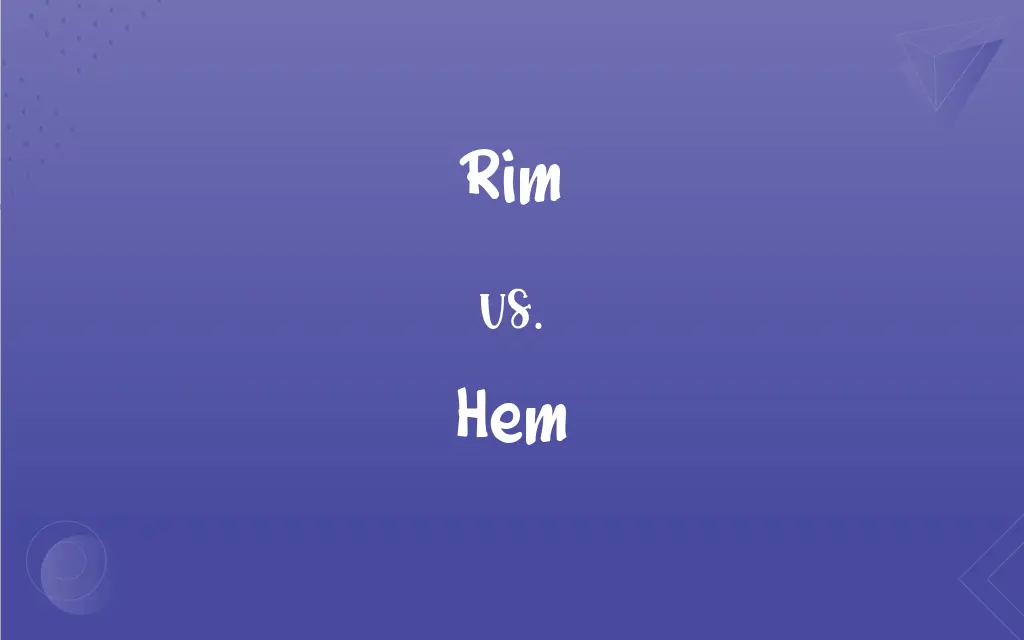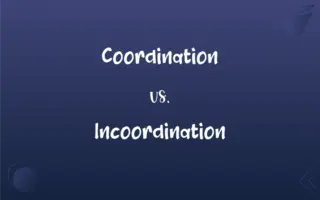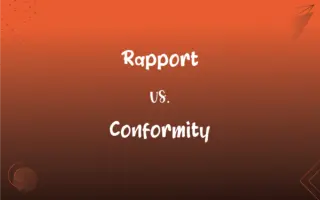Rim vs. Hem: What's the Difference?
By Janet White & Aimie Carlson || Updated on May 20, 2024
A rim is the outer edge of a circular object, such as a wheel or a cup, while a hem is the folded and sewn edge of fabric, typically found on clothing or linens.

Key Differences
A rim refers to the outer edge or boundary of a circular object, such as the rim of a wheel, a cup, or a basketball hoop. It often provides structural integrity and can be functional or decorative. A hem, on the other hand, is the edge of a piece of fabric that has been folded over and sewn to prevent fraying and to create a finished look. Hems are commonly found on clothing, curtains, and other textile products.
Rims are associated with various objects and are crucial for their function and durability. For example, the rim of a tire supports the tire and keeps it in place on the wheel. The rim of a glass provides a smooth edge for drinking. Hems are specific to textiles and serve both practical and aesthetic purposes. They prevent fabric edges from unraveling and add a polished finish to garments and home furnishings.
While rims are typically rigid and part of a solid structure, hems are flexible and part of a fabric's construction. The process of creating a rim involves molding or shaping materials, whereas hemming involves folding and stitching fabric.
Rims pertain to the outer edges of solid objects and are integral to their structure and function, while hems refer to the finished edges of fabrics, ensuring durability and a neat appearance.
Comparison Chart
Definition
Outer edge of a circular object
Folded and sewn edge of fabric
ADVERTISEMENT
Associated With
Wheels, cups, glasses, basketball hoops
Clothing, linens, curtains
Function
Provides structure and integrity
Prevents fraying, adds a finished look
Material
Rigid materials like metal, plastic, glass
Flexible materials like fabric
Creation Process
Molding, shaping
Folding, stitching
Common Examples
Rim of a wheel, rim of a cup
Hem of a dress, hem of a curtain
ADVERTISEMENT
Rim and Hem Definitions
Rim
The outer edge of a circular object.
The rim of the wheel was bent in the accident.
Hem
A finished edge on a garment.
The hem of his pants was frayed.
Rim
An edge that provides structural support.
The rim of the bicycle tire keeps it in place.
Hem
A folded and sewn edge for neatness.
The tablecloth had a beautifully stitched hem.
Rim
The top edge of a container or vessel.
He drank from the rim of the glass.
Hem
A method to prevent fabric from unraveling.
Curtains with a double hem are more durable.
Rim
A circular boundary or border.
The basketball hit the rim before going in.
Hem
An edge or border on a piece of cloth, especially a finished edge, as for a garment or curtain, made by folding an edge under and stitching it down.
Rim
The edge or margin of something round.
The potter carefully shaped the rim of the clay bowl.
Hem
The height or level of the bottom edge of a skirt, dress, or coat; a hemline.
Rim
The upper or outer edge of an object, especially when curved or circular.
Hem
A short cough or clearing of the throat made especially to gain attention, warn another, hide embarrassment, or fill a pause in speech.
Rim
The upper edge of a steep slope; a cliff or brink
The rim of a canyon.
Hem
To fold back and stitch down the edge of.
Rim
The circular outer part of a wheel, furthest from the axle.
Hem
To surround and shut in; enclose
A valley hemmed in by mountains.
Rim
A circular metal structure around which a wheel tire is fitted.
Hem
To utter a hem.
Rim
To furnish with a rim.
Hem
To hesitate in speech.
Rim
(Sports) To roll around the rim of (a basket or golf cup, for example) without falling in.
Hem
Used to fill in the gap of a pause with a vocalized sound.
Rim
An edge around something, especially when circular.
Hem
An utterance or sound of the voice like "hem", often indicative of hesitation or doubt, sometimes used to call attention.
Rim
A wheelrim.
Hem
(sewing) The border of an article of clothing doubled back and stitched together to finish the edge and prevent it from fraying.
Rim
(journalism) A semicircular copydesk.
Hem
A rim or margin of something.
Rim
A membrane.
Hem
In sheet metal design, a rim or edge folded back on itself to create a smooth edge and to increase strength or rigidity.
Rim
The membrane enclosing the intestines; the peritoneum, hence loosely, the intestines; the lower part of the abdomen; belly.
Hem
To make the sound expressed by the word hem; to hesitate in speaking.
Rim
(transitive) To form a rim on.
Hem
To make a hem.
Rim
(transitive) To follow the contours, possibly creating a circuit.
Palm trees rim the beach.
A walking path rims the island.
Hem
(transitive) To put hem on an article of clothing, to edge or put a border on something.
Rim
To roll around a rim.
The golf ball rimmed the cup.
The basketball rimmed in and out.
Hem
(transitive) To shut in, enclose, confine; to surround something or someone in a confining way.
A small yard hemmed about by a tall hedge.
Rim
(slang) To lick the anus of a partner as a sexual act.
Hem
Obsolete form of 'em
Rim
The border, edge, or margin of a thing, usually of something circular or curving; as, the rim of a kettle or basin.
Hem
Them
Rim
The lower part of the abdomen.
Hem
An onomatopoetic word used as an expression of hesitation, doubt, etc. It is often a sort of voluntary half cough, loud or subdued, and would perhaps be better expressed by hm.
Cough or cry hem, if anybody come.
Rim
To furnish with a rim; to border.
Hem
An utterance or sound of the voice, hem or hm, often indicative of hesitation or doubt, sometimes used to call attention.
Rim
The shape of a raised edge of a more or less circular object
Hem
The edge or border of a garment or cloth, doubled over and sewed, to strengthen it and prevent raveling.
Rim
(basketball) the hoop from which the net is suspended;
The ball hit the rim and bounced off
Hem
Border; edge; margin.
Rim
The outer part of a wheel to which the tire is attached
Hem
A border made on sheet-metal ware by doubling over the edge of the sheet, to stiffen it and remove the sharp edge.
Rim
A projection used for strength or for attaching to another object
Hem
To make the sound expressed by the word hem; hence, to hesitate in speaking.
Rim
The top edge of a vessel
Hem
To form a hem or border to; to fold and sew down the edge of.
Rim
Run around the rim of;
Sugar rimmed the dessert plate
Hem
To border; to edge
All the skirt aboutWas hemmed with golden fringe.
Rim
Furnish with a rim;
Rim a hat
Hem
Lap that forms a cloth border doubled back and stitched down
Rim
Roll around the rim of;
The ball rimmed the basket
Hem
Fold over and sew together to provide with a hem;
Hem my skirt
Hem
Utter `hem' or `ahem'
Hem
The edge of a piece of fabric that is folded over and sewn.
She sewed a hem on the bottom of the dress.
Hem
The act of creating a finished edge on fabric.
Hemming the skirt took her about an hour.
FAQs
What is a rim?
A rim is the outer edge of a circular object, providing structural integrity and support.
Where are rims commonly found?
Rims are commonly found on wheels, cups, glasses, and basketball hoops.
What is a hem?
A hem is the folded and sewn edge of a piece of fabric, used to prevent fraying and create a finished look.
What is the purpose of a rim?
The purpose of a rim is to provide structure, support, and a finished edge to circular objects.
Where are hems commonly found?
Hems are commonly found on clothing, linens, curtains, and other textile products.
How is a hem created?
A hem is created by folding and stitching the edge of a piece of fabric.
Can hems be decorative?
Yes, hems can be decorative, with various stitching techniques and finishes used to enhance the look of fabric items.
What materials are used for rims?
Materials such as metal, plastic, and glass are commonly used for rims.
What materials are used for hems?
Fabrics of various types, such as cotton, linen, and polyester, are used for hems.
What is the purpose of a hem?
The purpose of a hem is to prevent fabric edges from fraying and to give a neat, finished appearance.
Can rims be decorative?
Yes, rims can be both functional and decorative, enhancing the appearance of objects.
Are hems rigid or flexible?
Hems are flexible as they are part of a fabric's construction.
How is a rim created?
A rim is created by molding or shaping rigid materials like metal, plastic, or glass.
Is a rim always circular?
Yes, a rim typically refers to the outer edge of circular objects.
Can a rim affect the function of an object?
Yes, a damaged rim can affect the function and stability of objects like wheels and glasses.
Do rims serve a practical purpose?
Yes, rims provide structural support and integrity to the objects they are part of.
Do hems serve a practical purpose?
Yes, hems prevent fabric from fraying and add durability to textile products.
Can a hem affect the appearance of clothing?
Yes, a well-sewn hem can improve the appearance and longevity of clothing and other fabric items.
Are rims rigid or flexible?
Rims are typically rigid and part of a solid structure.
Can a hem be on non-circular fabric items?
Yes, hems can be on any fabric item, regardless of its shape.
About Author
Written by
Janet WhiteJanet White has been an esteemed writer and blogger for Difference Wiki. Holding a Master's degree in Science and Medical Journalism from the prestigious Boston University, she has consistently demonstrated her expertise and passion for her field. When she's not immersed in her work, Janet relishes her time exercising, delving into a good book, and cherishing moments with friends and family.
Co-written by
Aimie CarlsonAimie Carlson, holding a master's degree in English literature, is a fervent English language enthusiast. She lends her writing talents to Difference Wiki, a prominent website that specializes in comparisons, offering readers insightful analyses that both captivate and inform.































































